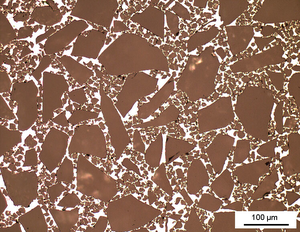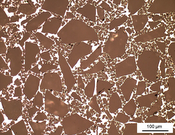Information
- Publication Type: Master Thesis
- Workgroup(s)/Project(s):
- Date: March 2008
- TU Wien Library:
- First Supervisor:
- Eduard Gröller
- H.P. Degischer
- M. Schobel
- Eduard Gröller
Abstract
The expansion behavior of particulate reinforced AlSiC metal matrix composites (MMCs) during a thermal cycle shows anomalies at temperatures above 250°C, explained by viscoplastic matrix deformations and changing void volume fractions. Volumetric images of the sample acquired by synchrotron tomography at several temperatures between 30°C and 400°C are used to analyze the void kinetics. These high-resolution low-contrast 3D + T images are not aligned, thus only allowing quantitative comparisons over areas comprising many voids. Analysis of speci c voids at various temperatures was not feasible, due to the three-dimensional misalignment. We present a 3D registration approach based on mutual information that allows for sub-pixel accurate registration. A maximum intensity projection (MIP) may be used for a manual pre-alignment. Further software tools for the analysis of void kinetics of AlSiC provide linked views for 2D slices, 3D isosurfaces, volume rendering, as well as overlaid contours (isolines) of multiple images on an arbitrarily positionable cutting plane, and the calculation of a shape factor. By registering the volumetric datasets, we were able to visualize the shrinkage and expansion of a speci c void during thermal cycling between room temperature and 400°C and to analyze the change of quantitative properties of speci c voids{including volume, surface, shape factor|resulting from temperature changes.Additional Files and Images
Weblinks
No further information available.BibTeX
@mastersthesis{altendorfer-2008-vts,
title = "Void Tracking in SiC Particle Reinforced Al",
author = "Wolfgang Altendorfer",
year = "2008",
abstract = "The expansion behavior of particulate reinforced AlSiC metal
matrix composites (MMCs) during a thermal cycle shows
anomalies at temperatures above 250°C, explained by
viscoplastic matrix deformations and changing void volume
fractions. Volumetric images of the sample acquired by
synchrotron tomography at several temperatures between 30°C
and 400°C are used to analyze the void kinetics. These
high-resolution low-contrast 3D + T images are not aligned,
thus only allowing quantitative comparisons over areas
comprising many voids. Analysis of speci
c voids at various
temperatures was not feasible, due to the three-dimensional
misalignment. We present a 3D registration approach based on
mutual information that allows for sub-pixel accurate
registration. A maximum intensity projection (MIP) may be
used for a manual pre-alignment. Further software tools for
the analysis of void kinetics of AlSiC provide linked views
for 2D slices, 3D isosurfaces, volume rendering, as well as
overlaid contours (isolines) of multiple images on an
arbitrarily positionable cutting plane, and the calculation
of a shape factor. By registering the volumetric datasets,
we were able to visualize the shrinkage and expansion of a
speci
c void during thermal cycling between room temperature
and 400°C and to analyze the change of quantitative
properties of speci
c voids{including volume, surface, shape
factor|resulting from temperature changes.",
month = mar,
address = "Favoritenstrasse 9-11/E193-02, A-1040 Vienna, Austria",
school = "Institute of Computer Graphics and Algorithms, Vienna
University of Technology ",
URL = "https://www.cg.tuwien.ac.at/research/publications/2008/altendorfer-2008-vts/",
}

 paper
paper

